Genesis and Related Reservoir Development Model of Ordovician Dolomite in Shuntogol Area, Tarim Basin
Abstract
:1. Introduction
2. Geological Setting
3. Materials and Methods
4. Results
4.1. Dolomite Petrology
4.2. Geochemical Characteristics
4.2.1. Cathode Luminescence Characteristics and Electron Probe Results
4.2.2. Carbon and Oxygen Isotope
4.2.3. Rare Earth Element
4.2.4. Order Degrees of Dolomite
5. Discussion
5.1. Origin of Dolomites
5.2. Dolomite-Related Reservoir Development Model
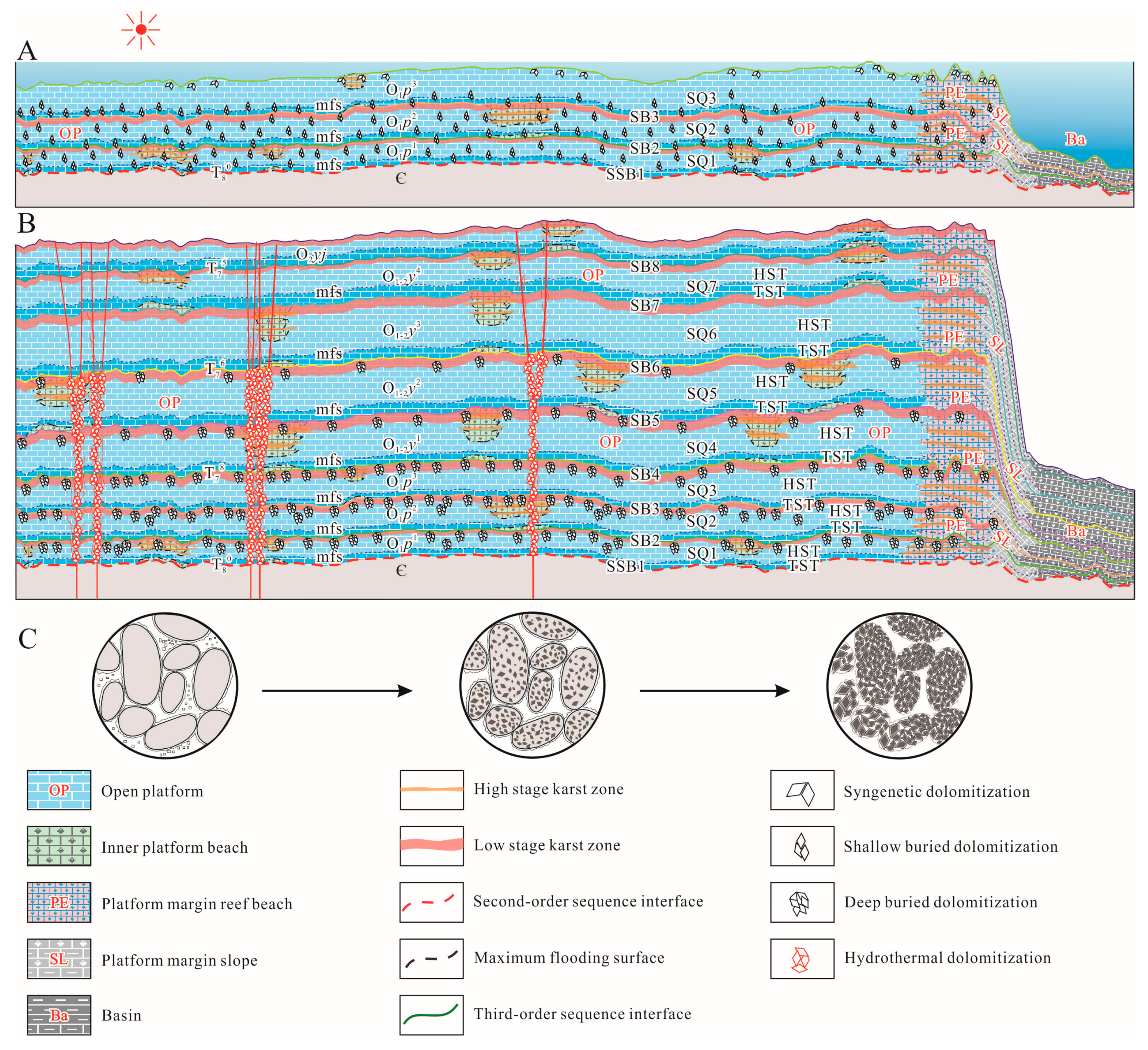
6. Conclusions
Author Contributions
Funding
Data Availability Statement
Acknowledgments
Conflicts of Interest
References
- Pan, L.Y.; Hao, Y.; Liang, F.; Hu, A.P.; Feng, Y.X.; Zhao, J.X. New evidence of laser in-situ U-Pb dating and isotopic geochemistry for the genesis of dolomite reservoir: A case study of dolomite reservoir from Middle Permian Qixia Formation in northwestern Sichuan Basin. Acta Pet. Sin. 2022, 43, 223–233, (In Chinese with English Abstract). [Google Scholar]
- Qiao, Z.; Yu, Z.; She, M.; Pan, L.; Zhang, T.; Li, W.; Shen, A. Progresses on ancient ultra-deeply buried marine carbonate reservoir in China. J. Palaeogeogr. 2023, 25, 1257–1276, (In Chinese with English Abstract). [Google Scholar]
- Ma, F.; Yang, L.M.; Gu, J.Y.; Chen, X.; Zhao, Z.; Jin, Y.N.; Gao, L. The summary on exploration of the dolomite oilfields in the world. Acta Sedimentol. Sin. 2011, 29, 1010–1021, (In Chinese with English Abstract). [Google Scholar]
- Warren, J. Dolomite: Occurrence, evolution and economically important associations. Earth-Sci. Rev. 2000, 52, 1–81. [Google Scholar] [CrossRef]
- Hardie, L.A. Dolomitization: A critical view of some current views. J. Sediment. Petrol. 1987, 57, 166–183. [Google Scholar] [CrossRef]
- Gregg, J.M.; Bish, D.L.; Kaczmarek, S.E.; Machel, H.G. Mineralogy, nucleation and growth of dolomite in the laboratory and sedimentary environment: A review. Sedimentology 2015, 62, 1749–1769. [Google Scholar] [CrossRef]
- Land, L.S. The origin of massive dolomite. J. Geol. Educ. 1985, 33, 112–125. [Google Scholar] [CrossRef]
- Liu, H.; Shi, K.; Liu, B.; Li, Y.; Li, Y.; Zheng, H.; Peng, Y.; Fu, Y. High-magnesium calcite skeletons provide magnesium for burrow-selective dolomitization in Cretaceous carbonates. Sedimentology 2024, 71, 383–418. [Google Scholar] [CrossRef]
- Lu, F.; Tan, X.; Zhong, Y.; Luo, B.; Zhang, B.; Zhang, Y.; Li, M.; Xiao, D.; Wang, X.; Zeng, W. Origin of the penecontemporaneous sucrosic dolomite in the Permian Qixia Formation, northwestern Sichuan Basin, SW China. Pet. Explor. Dev. 2020, 47, 1218–1234. [Google Scholar] [CrossRef]
- Duncan, F.S.; Jay, M.G. Classification of dolomite rock textures. J. Sediment. Petrol. 1987, 57, 967–975. [Google Scholar]
- Cai, W.K.; Liu, J.H.; Zhou, C.H.; Keeling, J.; Glasmacher, U.A. Structure, genesis and resource efficiency of dolomite: New insights and remaining enigmas. Chem. Geol. 2021, 573, 120191. [Google Scholar] [CrossRef]
- Wanas, H.A.; Sallam, E. Abiotically-formed, primary dolomite in the mid-Eocene lacustrine succession at Gebel El-Goza El-Hamra, NE Egypt: An approach to the role of smectitic clays. Sediment. Geol. 2016, 343, 132–140. [Google Scholar] [CrossRef]
- Rodriguez-Blanco, J.D.; Shaw, S.; Benning, L.G. A route for the direct crystallization of dolomite. Am. Mineral. 2015, 100, 1172–1181. [Google Scholar] [CrossRef]
- Zheng, H.; Lu, F.; Dong, Y.; Liu, B.; Zhang, X.; Shi, K.; He, J.; Qing, H. Magma-driven thermal convection dolomitization of the Lower-Middle Ordovician strata caused by Mg sourced from underlying Cambrian dolomites in the Tarim Basin, China. Mar. Pet. Geol. 2024, 163, 106740. [Google Scholar] [CrossRef]
- Peng, B.; Li, Z.; Li, G.; Li, C.; Zhu, S.; Zhang, W.; Zuo, Y.; Guo, Y.; Wei, X. Multiple dolomitization and fluid flow events in the Precambrian Dengying Formation of Sichuan Basin, Southwestern China. Acta Geol. Sin. 2018, 92, 311–332. [Google Scholar] [CrossRef]
- Ma, Y.S.; Li, M.W.; Cai, X.Y.; Xu, X.H.; Hu, D.F.; Qu, S.L.; Li, G.S.; He, D.F.; Xiao, X.M.; Zeng, Y.J.; et al. Mechanisms and exploitation of deep marine petroleum accumulations in China: Advances, technological bottlenecks and basic scientific problems. Oil Gas Geol. 2020, 41, 655–672+683, (In Chinese with English Abstract). [Google Scholar]
- Lu, X.B.; Hu, W.G.; Wang, Y.; Li, X.H.; Li, T.; Lv, Y.P.; He, X.M.; Yang, D.B. Characteristics and development practice of fault-karst carbonate reservoirs in Tahe area, Tarim Basin. Oil Gas Geol. 2015, 36, 347–355, (In Chinese with English Abstract). [Google Scholar]
- Ji, Y.G.; Han, J.F.; Zhang, Z.H.; Wang, J.Y.; Su, J.; Wang, Y.; Zhang, M. Formation and distribution of deep high quality reservoirs of Ordovician Yingshan formation in the Northern Slope of the Tazhong area in Tarim Basin. Acta Geol. Sin. 2012, 86, 1163–1174. (In Chinese) [Google Scholar]
- Sun, F.N.; Hu, W.X.; Hu, Z.Y.; Liu, Y.L.; Kang, X.; Zhu, F. Impact of hydrothermal activities on reservoir formation controlled by bothfaults and sequences boundaries: A case study from the Lower Ordovician in Tahe and Yubei areas, Tarim Basin. Oil Gas Geol. 2020, 41, 558–575, (In Chinese with English Abstract). [Google Scholar]
- Qi, J.S.; Zheng, X.P.; Huang, S.W.; Zhang, Y.; Shao, G.M. Characteristics of Yingshan dolomite Reservoir in Gucheng low swell of Tarim Basin with favorable area prediction. Xinjiang Pet. Geol. 2016, 37, 7–12, (In Chinese with English Abstract). [Google Scholar]
- Wu, S.Q.; Qian, Y.X.; Li, H.L.; Yang, S.J.; Sha, X.G.; Xia, Y.T.; Ma, Q.Y.; Zhu, X.X. Characteristics and main controlling factors of dolostone reservoir of the middle-lower Ordovician Yingshan formation in Katak Uplift of ‘Tarim Basin. J. Palaeogeogr. 2012, 14, 209–218, (In Chinese with English Abstract). [Google Scholar]
- Chen, H.H.; Lu, Z.Y.; Cao, Z.C.; Han, J.; Yun, L. Hydrothermal alteration of Ordovician reservoir in northeastern slope of Tazhong uplift, Tarim Basin. Acta Geol. Sin. 2015, 37, 43–63, (In Chinese with English Abstract). [Google Scholar]
- Lu, F.; Tan, X.; Xiao, D.; Shi, K.; Li, M.; Zhang, Y.; Zheng, H.; Dong, Y. Sedimentary control on diagenetic paths of dolomite reservoirs in a volcanic setting: A case study of the Permian Chihsia Formation in the Sichuan Basin, China. Sediment. Geol. 2023, 454, 106451. [Google Scholar] [CrossRef]
- Yu, J.; Shi, K.; Wang, Q.; Liu, B.; Han, J.; Song, Y.; Kong, Y.; Jiang, W. Structural diagenesis of deep carbonate rocks controlled by intra-cratonic strike-slip faulting: An example in the Shunbei area of the Tarim Basin, NW China. Basin Res. 2022, 34, 1601–1631. [Google Scholar] [CrossRef]
- Zhao, W.Z.; Shen, A.J.; Qiao, Z.F.; Pan, L.Y.; Hu, A.P.; Zhang, J. Genetic types and distinguished characteristics of dolomite and the origin of dolomite reservoirs. Pet. Explor. Dev. 2018, 45, 983–997. [Google Scholar] [CrossRef]
- Zhao, Y.Y.; Zhao, M.Y.; Li, S.Z. Evidences of hydrothermal fluids recorded in microfacies of the Ediacaran cap dolostone: Geochemical implications in South China. Precambrian Res. 2018, 306, 1–21. [Google Scholar] [CrossRef]
- Azmy, K.; Veizer, J.; Misi, A.; Oliverira, T.F.D.; Sanches, A.L.; Dardenne, M.A. Dolomitization and isotope stratigraphy of the Vazante formation, São Francisco Basin, Brazil. Precambrian Res. 2001, 112, 303–329. [Google Scholar] [CrossRef]
- Wang, S.; Cao, Y.H.; Du, D.D.; Zhang, Y.J.; Liu, C. Characteristics and pore genesis of dolomite in Ordovician Yingshan Formationin Gucheng area, Tarim Basin. Acta Petrol. Sin. 2020, 36, 3477–3492, (In Chinese with English Abstract). [Google Scholar]
- He, Y.; Han, Z.; Bai, X.L.; Zhu, S. Dolomite reservoir characteristics of lower Ordovician Penglaiba formation, Tarim Basin. Nat. Gas Technol. Econ. 2012, 6, 10–16. (In Chinese) [Google Scholar]
- Zheng, J.F.; Shen, A.J.; Qiao, Z.F.; Ni, X.F. Genesis of dolomite and main controlling factors of reservoir in Penglaiba formation of lower Ordovician, Tarim Basin: A case study of Dabantage outcrop in Bachu area. Acta Geol. Sin. 2013, 29, 3223–3232, (In Chinese with English Abstract). [Google Scholar]
- You, D.H.; Han, J.; Hu, W.X.; Chen, Q.L.; Cao, Z.C.; Xi, B.B.; Lu, Z.Y. Characteristics and genesis of dolomite reservoirs in the Yingshan formation of well SN501 in the Tarim Basin. Acta Geol. Sin. 2018, 36, 1206–1217. (In Chinese) [Google Scholar]
- Zheng, H.R.; Tian, J.C.; Hu, Z.Q.; Zhang, X.; Zhao, Y.Q.; Meng, W.B. Lithofacies palaeogeographic evolution and sedimentary model of the Ordovician in the Tarim Basin. Oil Gas Geol. 2022, 43, 733–745, (In Chinese with English Abstract). [Google Scholar]
- Boynton, W.V. Geochemistry of the rare earth elements: Meteorite studies. In Rare Earth Element Geochemistry; Henderson, P., Ed.; Elsevier: Amsterdam, The Netherlands, 1984; pp. 63–114. [Google Scholar]
- Wang, L.C.; Hu, W.X.; Wang, X.L.; Cao, J.; Wu, H.G.; Liao, Z.W.; Wan, Y. Variation of Sr content and 87Sr/86Sr isotope fractionation during dolomitization and their implications. Oil Gas Geol. 2016, 37, 464–472, (In Chinese with English Abstract). [Google Scholar]
- Liu, D.W.; Cai, C.F.; Hu, Y.J.; Jiang, L.; Li, R.; He, H.; Wang, S.; Peng, Y.Y.; Wei, T.Y.; Liu, Q.Y. Variations in analytical results of commonly used major and trace elements and isotopic analyses in carbonate studies: A case study on the Lower Cambrian Longwangmiao Formation in central Sichuan Basin. J. Palaeogeogr. 2022, 24, 524–539, (In Chinese with English Abstract). [Google Scholar]
- Lottermoser, B.G. Rare earth elements and hydrothermal ore formation processes. Ore Geol. Rev. 1992, 7, 25–41. [Google Scholar] [CrossRef]
- Jiang, W.J.; Hou, M.C.; Xing, F.C.; Xu, S.L.; Lin, L.B. Characteristics and indications of rare earth elements in dolomite of the Cambrian Loushanguan Group, SE Sichuan Basin. Oil Gas Geol. 2016, 37, 473–482. [Google Scholar]
- Zhao, Y.Y.; Zheng, Y.F.; Chen, F.K. Trace element and strontium isotope constraints on sedimentary environment of Ediacaran carbonates in southern Anhui, South China. Chem. Geol. 2009, 265, 345–362. [Google Scholar] [CrossRef]
- Hu, Z.G.; Zheng, R.C.; Hu, J.Z.; Wen, H.G.; Li, Y.; Wen, Q.B.; Xu, F.B. Geochemical characteristics of rare earth elements of Huanglong Formation dolomites reservoirs in eastern Sichuan-northern Chongqing area. Acta Geol. Sin. 2009, 83, 782–790. (In Chinese) [Google Scholar]
- Han, Y.X.; Li, Z.; Han, D.L.; Peng, S.T.; Liu, J.Q. REE characteristics of matrix dolomites and its origin of Lower Ordovician in eastern Tabei area, Tarim Basin. Acta Petrol. Sin. 2009, 25, 2405–2416, (In Chinese with English Abstract). [Google Scholar]
- Leng, M.J.; Marshall, D. Palaeoclimate interpretation of stable isotope data from lake sediment archives. Quat. Sci. Rev. 2004, 23, 811–831. [Google Scholar] [CrossRef]
- Zhang, J.; Jones, B.; Zhang, J.Y. Crystal structure of replacement dolomite with different buried depths and its significance to study of dolomite reservoir. China Pet. Explor. 2014, 19, 21–28, (In Chinese with English Abstract). [Google Scholar]
- Reeder, R.J.; Wenk, H.R. Structure refinements of some thermally disordered dolomites. Am. Mineral. 1983, 68, 769–776. [Google Scholar]
- Huang, S.J.; Qing, H.R.; Hu, Z.W.; Pei, C.R.; Wang, Q.D.; Wang, C.M.; Gao, X.Y. Cathodoluminescence and diagenesis of the carbonate rocks in Feixianguan Formation of Triassic, eastern Sichuan Basin of China. Earth Sci.—J. China Univ. Geosci. 2008, 33, 26–34, (In Chinese with English Abstract). [Google Scholar]
- Cheng, X.Z.; Li, P.P.; Zou, H.Y.; Wang, G.W.; Chen, G. Geochemical characteristics and fluid origin of the Changxing Formation dolomitic rock in the Xinglongchang area of east Sichuan Basin. Acta Geol. Sin. 2013, 87, 1031–1040. (In Chinese) [Google Scholar]
- Dix, G.R. Patterns of burial-and tectonically controlled dolomitization in an Upper Devonian fringing-reef complex: Leduc Formation, Peace River Arch area, Alberta, Canada. J. Sediment. Res. 1993, 63, 628–640. [Google Scholar]
- Zheng, J.F.; Shen, A.J.; Liu, Y.F.; Chen, Y.Q. Multi-parameter comprehensive identification of the genesis of Lower Paleozoic dolomite in Tarim Basin, China. Acta Pet. Sin. 2012, 33, 145–153, (In Chinese with English Abstract). [Google Scholar]
- Walker, G.; Abumere, O.E.; Kamaluddin, B. Luminescence spectroscopy of Mn2+ rock-forming carbonates. Mineral. Mag. 1989, 53, 201–211. [Google Scholar] [CrossRef]
- Su, Z.T.; Chen, H.D.; Xu, F.Y.; Wei, L.B.; Li, J. Geochemistry and dolomitization mechanism of Majiagou dolomites in Ordovician, Ordos, China. Acta Petrol. Sin. 2011, 27, 2230–2238, (In Chinese with English Abstract). [Google Scholar]
- Fuchtbauer, H. Sediments and Sedimentary Rocks; John Wiley & Sons Inc.: New York, NY, USA, 1974. [Google Scholar]
- Huang, S.J. The degree of order and forming conditions of the dolomite of the third and fourth members of Lower Triassic Jialingjiang Formation in Longmenxia, Quxian, Sichuan. J. Mineral. Petrol. 1985, 5, 57–62. (In Chinese) [Google Scholar]
- Zhong, Q.Q.; Huang, S.J.; Zou, M.L.; Tong, H.P.; Huang, K.K.; Zhang, X.H. Controlling factors of order degree of dolomite in carbonate rocks: A case study from Lower Paleozoic in Tahe oilfield and Triassic in northeastern Sichuan Basin. Lithol. Reserv. 2009, 21, 50–55. [Google Scholar]
- Chen, Y.Q.; Zhou, X.Y.; Zhao, K.D.; Yang, W.J.; Ruan, Y.; Dong, C.Y. Geochemical research on Middle Cambrian red dolostones in Tarim Basin: Implications for dolostone genesis. Geol. J. China Univ. 2008, 14, 583–592, (In Chinese with English Abstract). [Google Scholar]
- Qiao, Z.F.; Zhang, T.F.; He, X.Y.; Xiong, R. Development and exploration direction of bedded massive dolomite reservoir of Lower Ordovician Penglaiba formation in Tarim Basin. Earth Sci. 2023, 48, 673–689, (In Chinese with English Abstract). [Google Scholar]
- He, Z.L.; Gao, Z.Q.; Zhang, J.T.; Ding, X.; Jiao, C.L. Types of sequence boundaries and their control over formation and distribution of quality carbonate reservoirs. Oil Gas Geol. 2014, 35, 853–859, (In Chinese with English Abstract). [Google Scholar]
- Feng, Z.H.; Shao, H.M.; Liu, Y.M.; Lu, X.; Zhao, W.; Bai, X.J.; Xu, Z.Y. Study on the relationship between the Ordovician diagenetic fluid and carbonate reservoir development in Gucheng area, Tarim Basin. China Pet. Explor. 2022, 27, 47–60, (In Chinese with English Abstract). [Google Scholar]
- Zhao, W.Z.; Shen, A.J.; Hu, S.Y.; Pan, W.Q.; Zheng, J.F.; Qiao, Z.F. Types and distributional features of Cambrian-Ordovician dolostone reservoirs in Tarim Basin, northwestern China. Acta Petrol. Sin. 2011, 28, 758–768, (In Chinese with English Abstract). [Google Scholar]
- Song, G.; Li, H.Y.; Ye, N.; Han, J.; Xiao, C.Y.; Lu, Z.Y.; Li, Y.T. Types and features of diagenetic fluids in Shunbei No. 4 strike-slip fault zone in Shuntuoguole Low Uplift, Tarim Basin. Pet. Geol. Exp. 2022, 44, 603–612, (In Chinese with English Abstract). [Google Scholar]
- Wang, Y.W.; Chen, H.H.; Guo, H.F.; Zhu, Z.H.; Wang, Q.R.; Yu, P.; Qi, L.X.; Yun, L. Hydrocarbon charging history of the ultra-deep reservoir in Shun 1 strike-slip fault zone, Tarim Basin. Oil Gas Geol. 2019, 40, 972–989, (In Chinese with English Abstract). [Google Scholar]
- Fu, H.; Han, J.H.; Meng, W.B.; Feng, M.S.; Hao, L.; Gao, Y.F.; Guan, Y.S. Forming mechanism of the Ordovician karst carbonate reservoirs on the northern slope of Central Tarim Basin. Nat. Gas Ind. 2017, 37, 25–36, (In Chinese with English Abstract). [Google Scholar] [CrossRef]
- Yu, B.S.; Chen, J.Q.; Lin, C.S. Sequence stratigraphic framework and its control on development of Ordovician carbonate reservoir in Tarim basin. Oil Gas Geol. 2005, 26, 305–316, (In Chinese with English Abstract). [Google Scholar]
- Wang, W.B.; Fu, H.; Yan, L.R.; Zhu, M.Q.; Chen, K.; Zhang, Z.N.; Liu, X.B.; Xiong, R.; Wang, R.G.; Zhou, Y. Sequence Model of Ordovician Carbonate Strata in Shunbei area, Tarim Basin, and Its Significance. Acta Geol. Sin. 2021, 39, 1451–1465, (In Chinese with English Abstract). [Google Scholar]
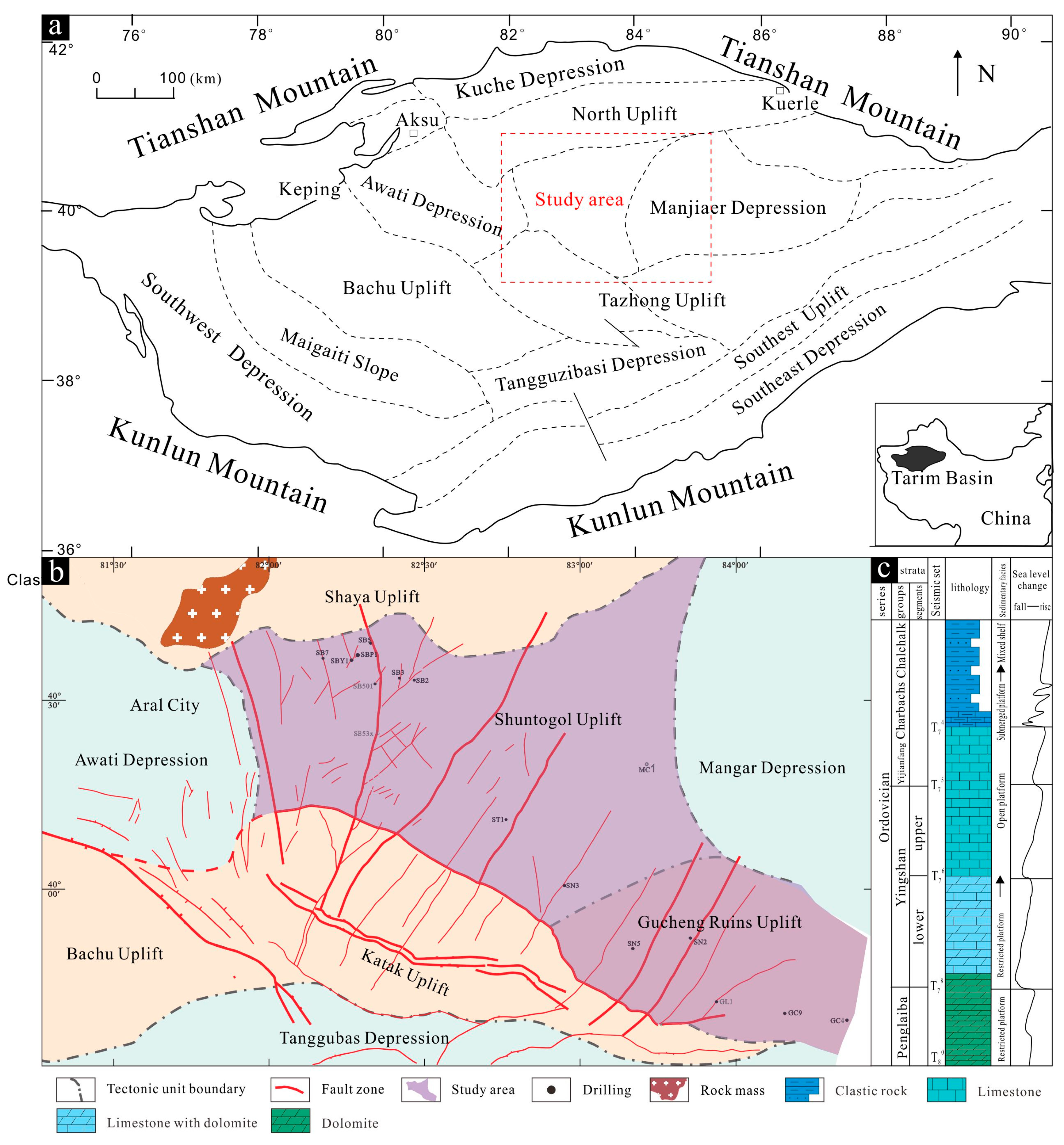
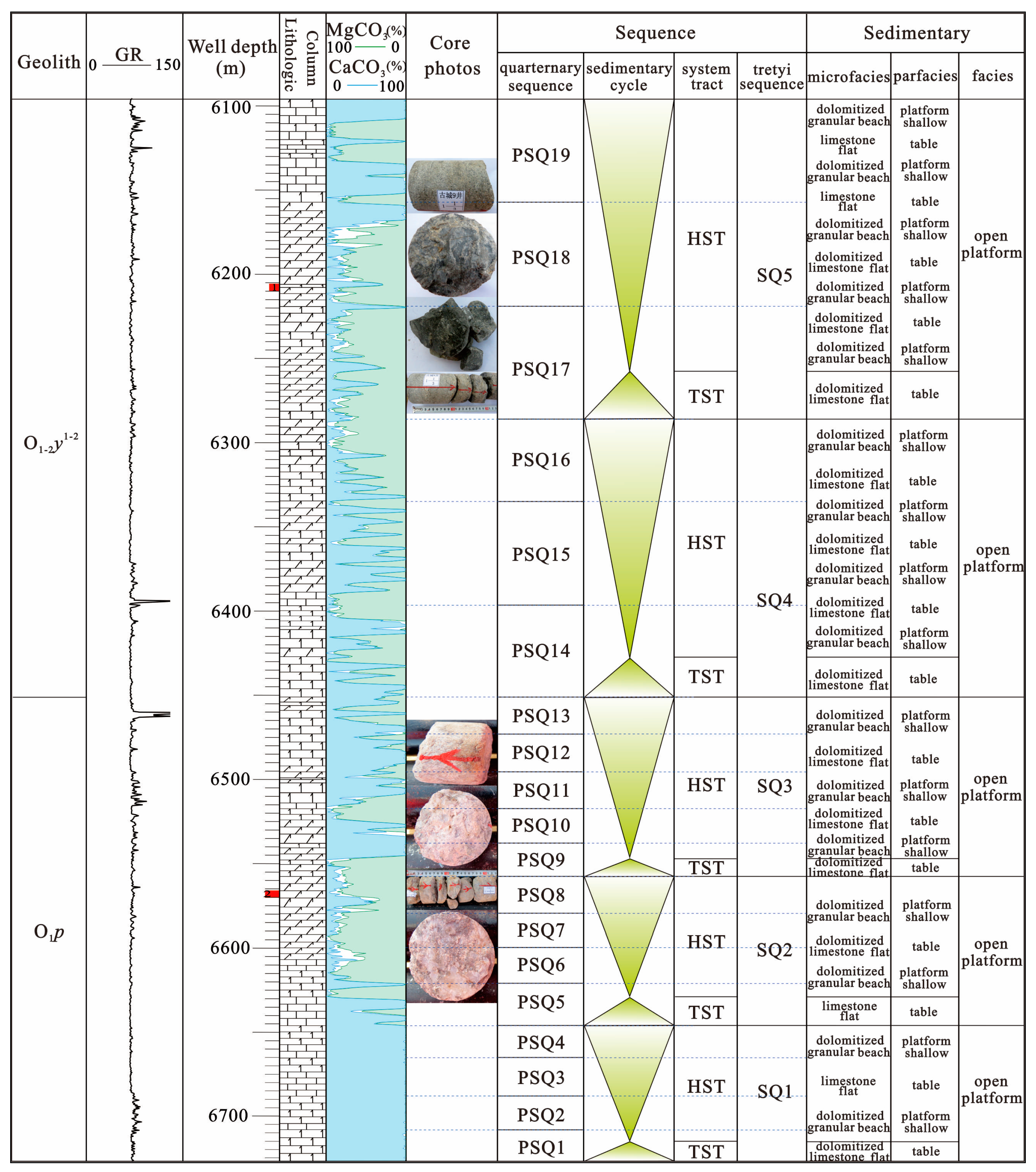
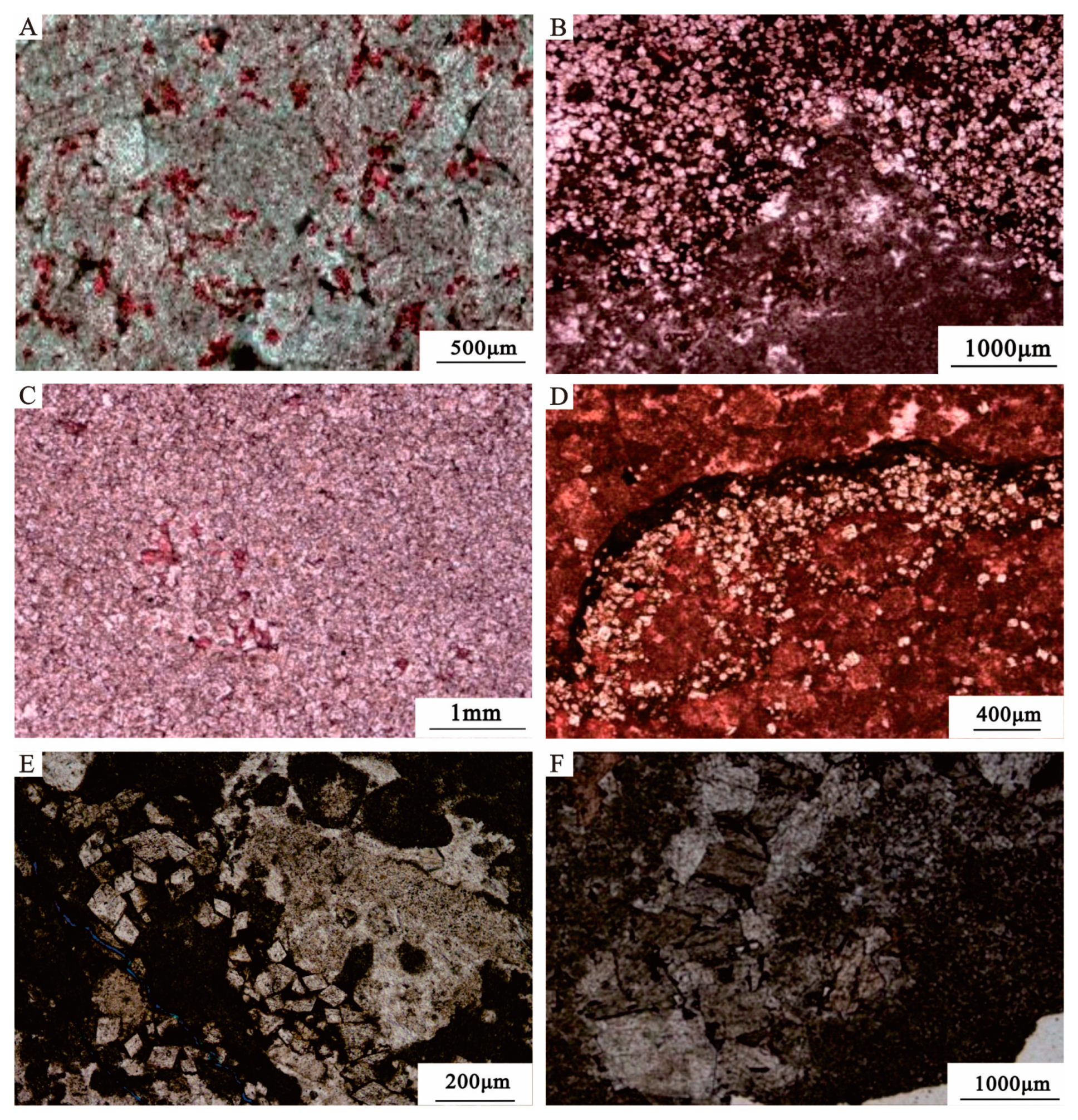

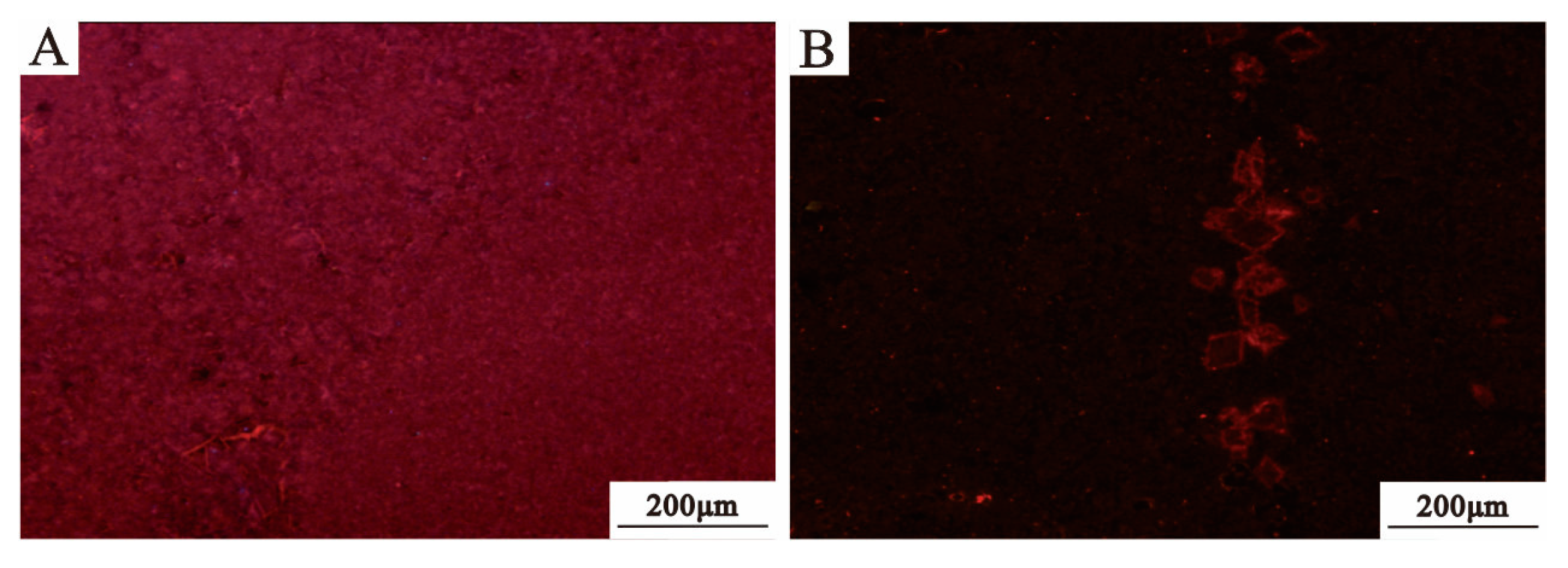
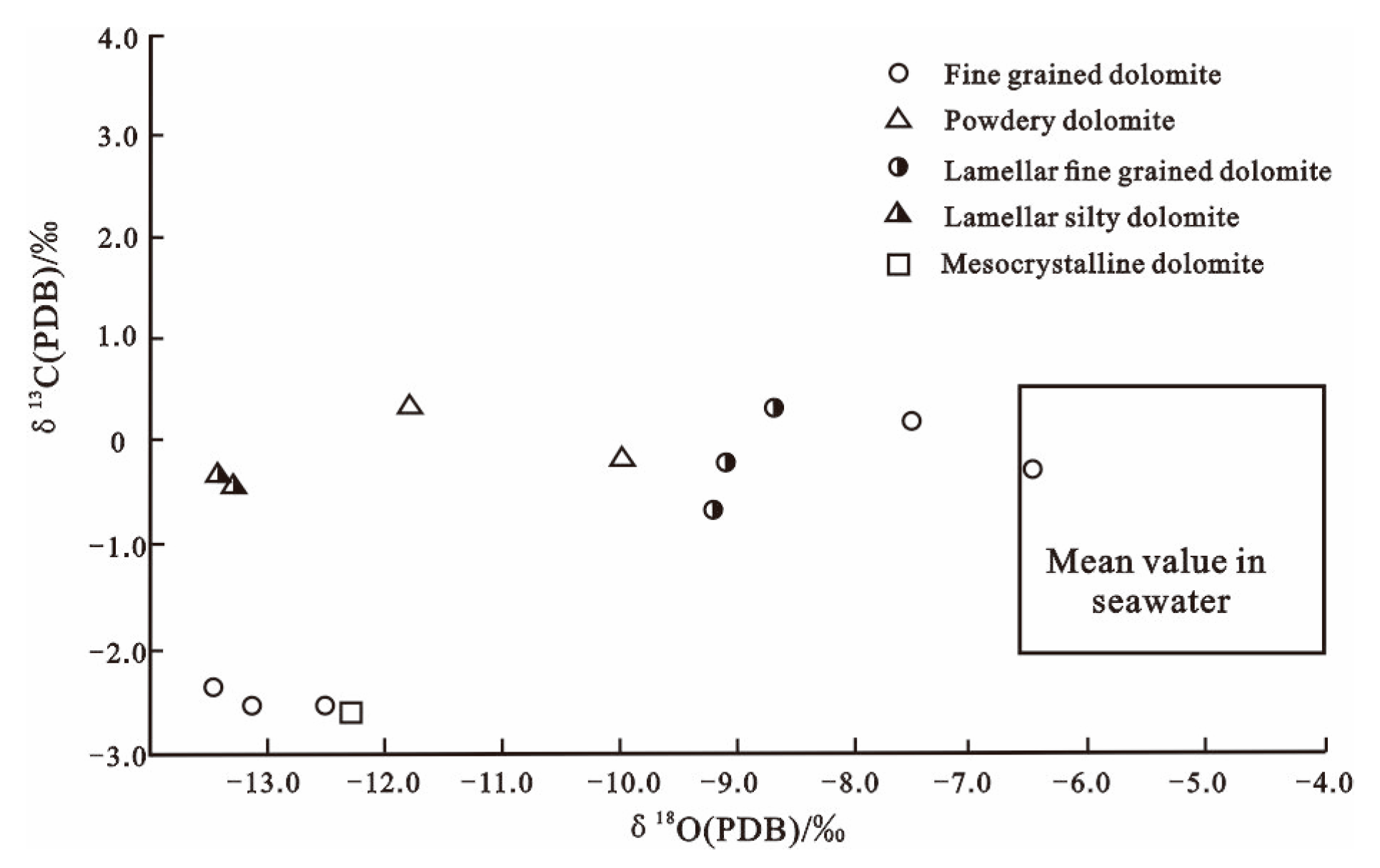

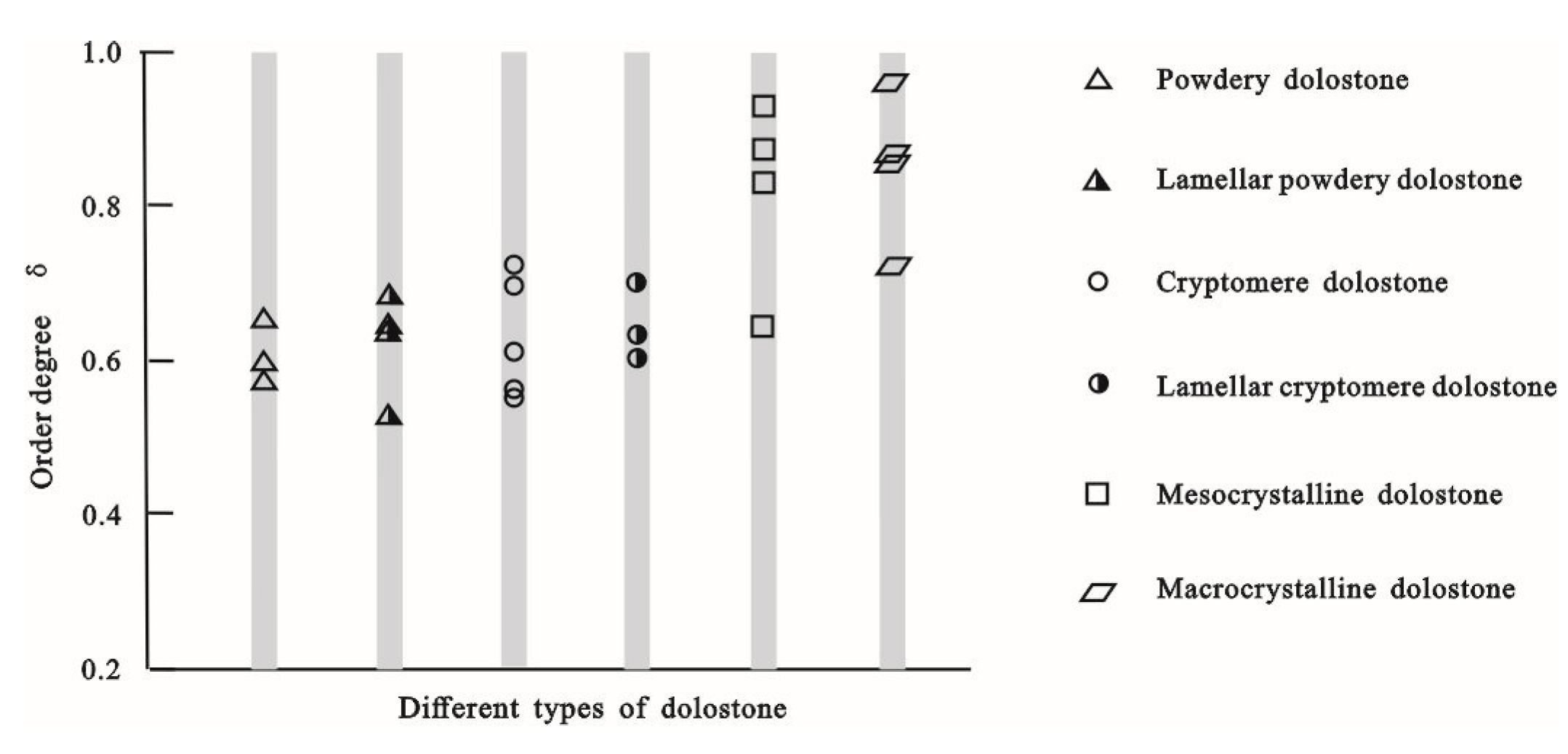
| Strata | Lithology | Porosity Max/% | Porosity Min/% | Porosity Mean/% | Permeability Max/md | Permeability Min/md | Permeability Mean/md |
|---|---|---|---|---|---|---|---|
| Lower member of Yingshan Formation | Dolostone | 2.30 | 0.20 | 1.13 | 14.50 | 0.001 | 1.19 |
Disclaimer/Publisher’s Note: The statements, opinions and data contained in all publications are solely those of the individual author(s) and contributor(s) and not of MDPI and/or the editor(s). MDPI and/or the editor(s) disclaim responsibility for any injury to people or property resulting from any ideas, methods, instructions or products referred to in the content. |
© 2024 by the authors. Licensee MDPI, Basel, Switzerland. This article is an open access article distributed under the terms and conditions of the Creative Commons Attribution (CC BY) license (https://creativecommons.org/licenses/by/4.0/).
Share and Cite
Zhong, L.; Cheng, L.; Fu, H.; Zhao, S.; Ye, X.; Ding, Y.; Senlin, Y. Genesis and Related Reservoir Development Model of Ordovician Dolomite in Shuntogol Area, Tarim Basin. Minerals 2024, 14, 545. https://doi.org/10.3390/min14060545
Zhong L, Cheng L, Fu H, Zhao S, Ye X, Ding Y, Senlin Y. Genesis and Related Reservoir Development Model of Ordovician Dolomite in Shuntogol Area, Tarim Basin. Minerals. 2024; 14(6):545. https://doi.org/10.3390/min14060545
Chicago/Turabian StyleZhong, Liangxuanzi, Leli Cheng, Heng Fu, Shaoze Zhao, Xiaobin Ye, Yidong Ding, and Yin Senlin. 2024. "Genesis and Related Reservoir Development Model of Ordovician Dolomite in Shuntogol Area, Tarim Basin" Minerals 14, no. 6: 545. https://doi.org/10.3390/min14060545




